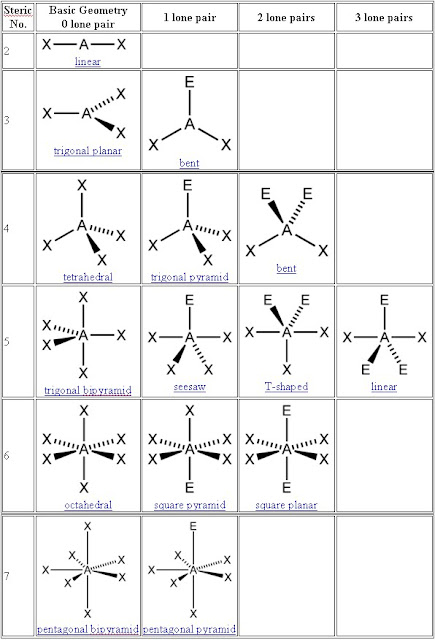Valence Shell Electron Pair Repulsion Theory
Valence shell electron pair repulsion (VSEPR) theory is a model in chemistry used to predict the shape of individual molecules based upon the extent of electron-pair electrostatic repulsion. It is also named Gillespie-Nyholm theory after its two main developers. The acronym "VSEPR" is sometimes pronounced "vesper" for ease of pronunciation.
The premise of VSEPR is that the valence electron pairs surrounding an atom mutually repel each other, and will therefore adopt an arrangement that minimizes this repulsion, thus determining the molecular geometry. The number of electron pairs surrounding an atom, both bonding and nonbonding, is called its steric number.
VSEPR theory is usually compared and contrasted with valence bond theory, which addresses molecular shape through orbitals that are energetically accessible for bonding. Valence bond theory concerns itself with the formation of sigma and pi bonds. Molecular orbital theory is another model for understanding how atoms and electrons are assembled into molecules and polyatomic ions.
VSEPR theory has long been criticized for not being quantitative, and therefore limited to the generation of "crude", even though structurally accurate, molecular geometries of covalent molecules. However, molecular mechanics force fields based on VSEPR have also been developed.


As reference and predicting the VSEPR structure, you may visit http://winter.group.shef.ac.uk/chemputer/vsepr.html
The premise of VSEPR is that the valence electron pairs surrounding an atom mutually repel each other, and will therefore adopt an arrangement that minimizes this repulsion, thus determining the molecular geometry. The number of electron pairs surrounding an atom, both bonding and nonbonding, is called its steric number.
VSEPR theory is usually compared and contrasted with valence bond theory, which addresses molecular shape through orbitals that are energetically accessible for bonding. Valence bond theory concerns itself with the formation of sigma and pi bonds. Molecular orbital theory is another model for understanding how atoms and electrons are assembled into molecules and polyatomic ions.
VSEPR theory has long been criticized for not being quantitative, and therefore limited to the generation of "crude", even though structurally accurate, molecular geometries of covalent molecules. However, molecular mechanics force fields based on VSEPR have also been developed.


As reference and predicting the VSEPR structure, you may visit http://winter.group.shef.ac.uk/chemputer/vsepr.html
Comments